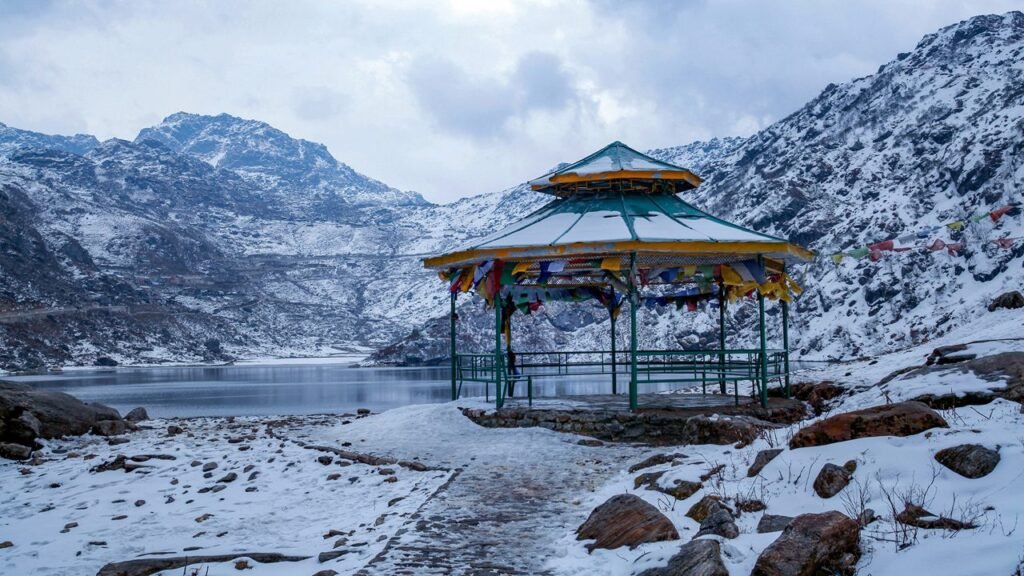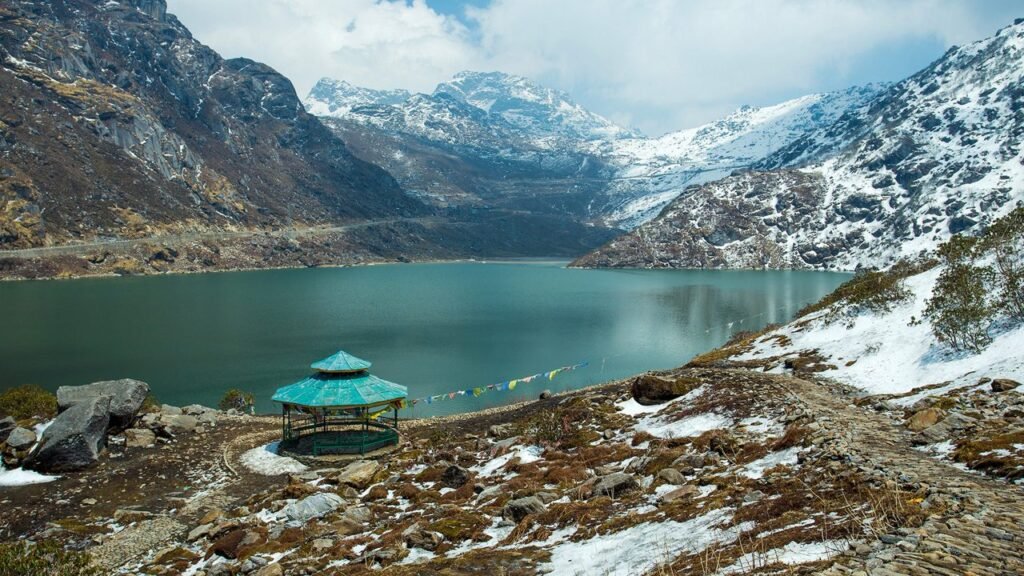Tsomgo Lake, also called Tsongmo or Changu Lake, is a gem nestled in the Himalayan slopes of East Sikkim, India. Renowned for its crystal waters reflecting the changing seasons and shrouded in rich folklore, Tsomgo is both a revered spiritual site and a premier tourist attraction.
Overview: Location & Geography
Tsomgo Lake sits at a breathtaking elevation of 3,753 meters (12,313 feet) on the Gangtok-Nathula highway, about 40 kilometers from Sikkim’s capital, Gangtok. This oval-shaped, glacial lake stretches approximately 1 km in length and about 15 meters deep, flanked by rugged mountain slopes and abundant wildflowers.
The lake is fed by melting snow from the surrounding hills and remains frozen from January through mid-May, offering dramatic landscapes, pristine blue in summer and a surreal, icy expanse in winter.
Myth, Legend, and Cultural Heritage
Tsomgo Lake is steeped in myth. Local Bhutanese and Lepcha stories tell of yak herders who once grazed animals in the valley where the lake sits. According to legend, an old woman foresaw in a dream that a great flood would create the lake, warning some herders to flee. Those ignoring the advice perished, while the lake formed overnight, now believed haunted by yaks on full moon nights.
The name “Tsomgo” derives from the Bhutia words “Tso” (lake) and “Mgo” (head/source). Local Buddhist monks were believed to predict the future by observing the water’s changing colors, gloomy hues foreshadowed unrest, while clear reflections signaled prosperity.
Both Hindus and Buddhists consider the lake sacred, honoring it with annual festivals and prayers. A small Shiva temple on its banks further testifies to its spiritual magnetism.
Tourism and Attractions
Yak Rides and Sightseeing
One of Tsomgo Lake’s signature attractions is the brightly-decorated yak rides around the lake’s shore, captivating adults and children alike. A nearby bazaar serves hot local snacks and souvenirs, making it a sociable universal attraction.
Seasonal Beauty
- Spring (April-June): The hillsides erupt with blooming rhododendrons, primulas, and poppies.
- Winter (Jan-March): The lake freezes solid, its surroundings cloaked in snow. Activities include snow play and winter trekking.
Wildlife and Birdwatching
The area is home to rare species such as the red panda, Himalayan black bear, musk deer, and migratory Brahminy ducks. Over 200 bird species have been recorded, making it a hotspot for nature lovers.
Access and Permits
- From Gangtok: The lake is accessible by car or taxi (shared/private) with a journey time of about 1.5 to 2 hours.
- Permits: Indian nationals require an Inner Line Permit (ILP), while foreign visitors must obtain a Protected Area Permit (PAP). These are available from travel agencies in Gangtok, as Tsomgo is close to the Indo-China border and is a protected region.
Adventure and Nearby Spots
Many travelers pair a visit to Tsomgo with the Baba Harbhajan Singh Mandir and Nathula Pass, the Indo-China border crossing, famed for its dramatic views and strategic importance.

Ecological Importance and Conservation
Tsomgo Lake is not only a stunning landmark but also a sensitive ecosystem. Its catchment is part of the Kyongnosla Alpine Sanctuary, host to endangered flora and fauna. However, increased tourism brings mounting environmental threats, plastic waste, water contamination, and fragile biodiversity.
To address this, “Tsomgo Pokhri Sanrakshan Samiti” was founded in 2008, involving local communities in daily clean-up drives and conservation efforts, crucial for balancing economic benefit with environmental stewardship.
Economic Impact and Tourism Revenue
Tsomgo Lake is among Sikkim’s top tourist earners, drawing roughly 300,000 visitors annually. Revenue comes from permit fees, yak rides, food stalls, and seasonal fairs. Local shops and hospitality have flourished, creating jobs and sustaining families.
Plans for a ropeway project and better amenities were floated to boost both visitor numbers and the local economy, but faced temporary legal hurdles due to ecological concerns. The government continues to balance sustainable tourism with responsible development.
Route and Travel Details
How to Get to Tsomgo Lake
- By Air: Nearest airport: Pakyong (55 km), but Bagdogra (IXB, ~125 km) is more commonly used.
- By Rail: New Jalpaiguri station (NJP, 120 km from Gangtok).
- By Road: Hired taxis or cars are the only way from Gangtok, expect 40 km of winding, scenic Himalayan roads, with steep climbs and periodic army checkpoints.
Best Time to Visit: While open all year, summer (April–June) and autumn (October–December) are popular. Winter visits reward with dramatic snowscapes but can see travel curbs due to road closures after heavy snowfall.
Recent News and Safety Updates
- June 2025: Authorities closed all tourist permits to Tsomgo Lake after heavy, record-setting snowfall, stressing the need for safety and responsible travel. Travelers are urged to verify route and permit status before planning trips, especially during winter months.
- The route remains a lifeline connecting Sikkim’s key border outposts, adding a strategic dimension to civilian visits.
FAQs About Tsomgo Lake
Why is Tsomgo Lake famous?
Tsomgo Lake is renowned for its spiritual significance, breathtaking scenery, and unique seasonal changes, as well as its role as Sikkim’s premier tourist attraction.
Is Tsomgo Lake accessible year-round?
Yes, but access can be halted in winter if snowfall blocks roads or during special border-related security alerts. Always check current route status before travel.
What are the permit requirements?
Indians need an Inner Line Permit, and foreigners require a Protected Area Permit. Both are issued only via registered travel agencies in Gangtok, as this is a protected border region.
What are the main cultural beliefs associated with the lake?
Both Buddhists and Hindus view Tsomgo Lake as sacred. Local festivals, rituals, and oracle readings by monks add profound spiritual meaning to visits.
What wildlife can be seen?
Visitors may spot rare species such as the red panda, musk deer, Brahminy ducks, and, seasonally, migratory birds making the area a haven for wildlife enthusiasts.
How does tourism impact the lake?
While tourism drives revenue and local prosperity, unmanaged growth has threatened ecological balance. Community-run clean-up initiatives and conservation rules are now actively enforced.
What are popular activities at Tsomgo Lake?
Besides sightseeing, popular activities include yak rides, photography, bird watching, local shopping, and visiting nearby sites like Nathula Pass and Baba Mandir.
Essential Visitor Tips
- Altitude Prep: At over 3,700m, some visitors may feel the effects of high altitude. Carry basic medications, hydrate, and acclimatize in Gangtok if needed.
- Clothing: Warm, layered clothing is necessary even in summer. Winters require heavy winter gear.
- Travel Light: Carry required IDs, permits, snacks, and water. Avoid single-use plastics to help conservation efforts.
- Travel Weather: Always check road and weather status close to your date of travel, especially in the monsoon and winter months.
The Future of Tsomgo Lake
Tsomgo Lake’s continued allure, both as a sacred pilgrimage site and an ecological marvel, depends on sustainable management and responsible tourism. With judicious visitor practices, community-led conservation, and evolving infrastructure, the region stands as a model for balancing natural beauty with cultural and economic prosperity.
